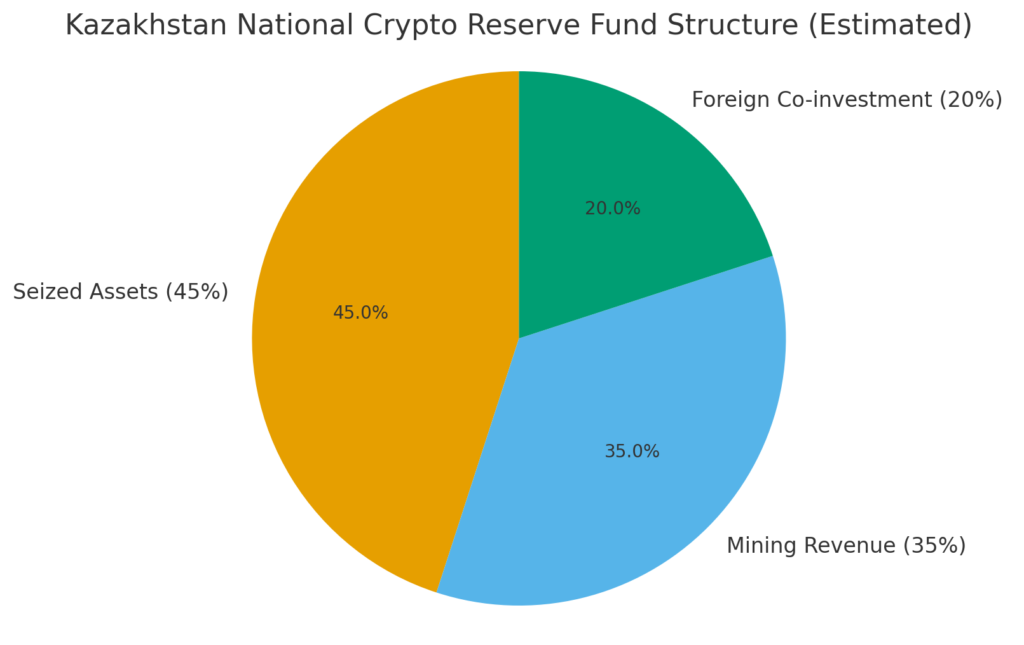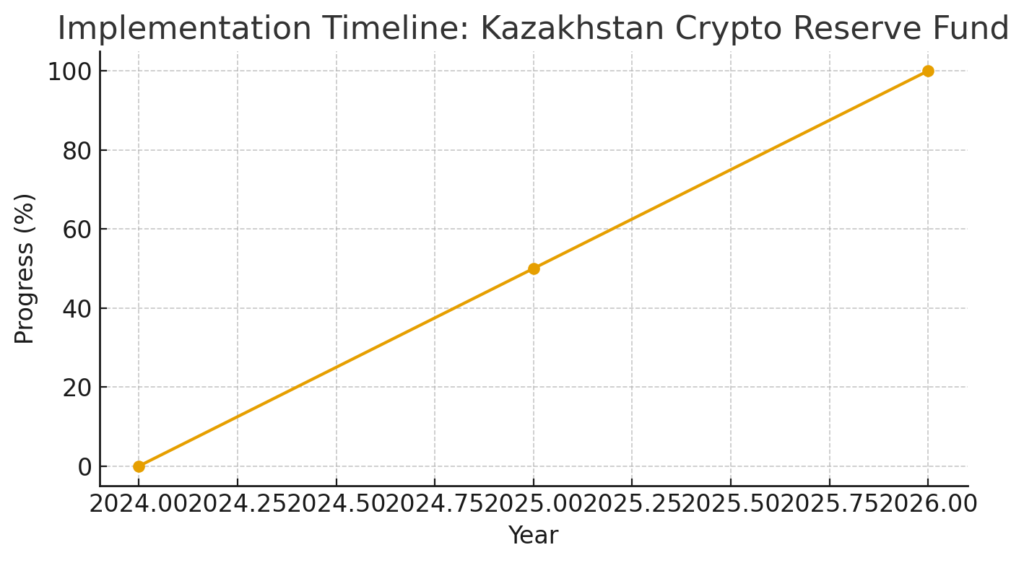
Main Points :
- Kazakhstan is planning to establish a national crypto-asset reserve fund of approximately US$500 million to US$1 billion by early 2026.
- The fund will be financed using assets seized from financial crime and revenues from state-authorised cryptocurrency mining operations.
- Instead of directly holding major tokens like Bitcoin or Ethereum, the fund will invest in crypto-related ETFs and shares in blockchain/digital-asset companies, aiming to reduce volatility risk.
- The fund will be managed via the Astana International Financial Centre (AIFC), which already serves as the fintech/crypto hub of Kazakhstan.
- This move forms part of Kazakhstan’s broader strategy to transition from an energy-/mining-based economy to a digital-asset and blockchain finance hub, while also diverting illicit crypto flows into productive investment.
Introduction: A Strategic Shift in National Reserves
Kazakhstan is moving into a new chapter of digital-finance strategy. By planning a state-backed crypto reserve fund, the government intends to convert seized assets and mining profits into structured investments in the crypto ecosystem. For readers interested in new crypto assets, revenue opportunities and real-world blockchain applications, this offers a noteworthy case: a sovereign state integrating intangible digital-asset exposure via regulated vehicles rather than raw token accumulation.
1. The Vision for the Fund
Kazakhstan plans to launch a national cryptocurrency reserve fund with a target capitalization between US$500 million and US$1 billion, operationally slated for early 2026. The idea is to harness value from existing digital-asset flows — namely seized assets from financial crime and licensed mining operations — and channel them into institutional-style investment vehicles tied to crypto and blockchain infrastructure.This is less about immediate token speculation and more about establishing a durable foothold in the digital-asset economy.
2. Funding Sources: Seized Assets + Mining Revenue

The key novelty here is the funding model. Rather than raising fresh capital, the Kazakh authorities plan to use:
- Assets confiscated in connection with financial crime (including digital-assets).
- Profits derived from state-approved crypto-mining operations inside Kazakhstan.
This two-pronged funding mechanism has multiple advantages: it recycles formerly idle or illicit digital-asset value into official channels, it leverages Kazakhstan’s existing mining base (Kazakhstan has been a major mining jurisdiction), and it minimizes new budgetary outlays. For practitioners interested in blockchain use-cases in sovereign finance or asset-defence strategies, this represents a convergence of regulatory enforcement, digital-asset monetisation, and strategic investment.
3. Investment Strategy: Indirect Exposure to Crypto Markets

Rather than holding tokens directly — for example bitcoin or ethereum — the fund will invest via regulated instruments: crypto-related ETFs and shares of blockchain/digital-asset companies. The logic is to capture upside from the crypto sector without exposing the fund to the full amplitude of token price volatility. For example, utilizing ETFs gives diversification, institutional oversight, and perhaps better regulatory compliance. For readers searching for next-generation assets, this signals that sovereign actors may view digital-assets more as infrastructure/financial-innovation plays rather than pure speculation.
4. Management and Institutional Framework
The fund will be operated through the Astana International Financial Centre (AIFC), which serves as Kazakhstan’s fintech and digital-finance hub. AIFC already hosts crypto exchanges and blockchain startups under a regulated framework. By placing the fund within the AIFC structure, Kazakhstan is signalling its desire for transparency, compliance with international standards, and a global investor-friendly platform. This institutional backing may reduce execution risk and provide a replicable model for other jurisdictions.
5. Strategic Context: From Mining Hub to Digital-Finance Hub
Kazakhstan has long been a significant global player in crypto-mining, particularly after China’s crackdown on mining operations. However, the mining boom brought large energy demands and governance challenges (including illegal farms and power grid stress). With this new fund initiative, Kazakhstan is pivoting from raw mining and resource-extraction to structured capital allocation in digital finance. The move underscores a broader push to diversify its economy away from fossil fuels and raw materials, and towards blockchain, fintech and digital infrastructure. For blockchain practitioners and crypto-asset seekers, this trend highlights that national-level participation in crypto isn’t limited to token holding but also infrastructure, regulation and finance.
6. Implications for Crypto Investors and Blockchain Practitioners
a) New Asset-Signals
When a sovereign state establishes a reserve fund with exposure to blockchain/crypto infrastructure, that sends a signal of maturation in the digital-asset ecosystem. It may encourage more institutional capital flow into related sectors (exchanges, infrastructure, regulated funds). For someone scouting new assets or revenue streams, look not just at tokens but at companies and instruments that support crypto (mining, staking services, institutional custody, ETF issuers, compliance tools).
b) Structural Use-case for Blockchain Finance
This initiative demonstrates a real-world use-case for blockchain assets beyond retail speculation: sovereign asset conversion, reserve diversification, mining integration, and regulated investment vehicles. For wallet developers, VASP players or fintech applications (like the non-custodial wallet you’re developing), such a backdrop enriches the narrative: digital assets aren’t just for DeFi anymore — they’re entering state balance sheets and regulated frameworks.
c) Risk-Management Lessons
By choosing ETFs and company shares over direct token holdings, the fund optimises for lower volatility and greater institutional comfort. For projects and investors, this underscores the importance of structuring exposure to crypto in a way that mitigates extreme downside. As you assess token issuance, wallet integrations or token-economy design (for your ‘Two-Extremes Model’), think about how you bundle or hedge volatility, compliance, and institutional integration.
7. Recent Developments & Broader Trend Alignment
Several recent developments align with Kazakhstan’s strategy and amplify its relevance:
- The country has introduced an offshore yuan-linked stablecoin through a Chinese fintech partner, signalling cross-border blockchain ambition.
- In October 2025, Kazakhstan launched the Alem Crypto Fund in partnership with Binance, marking its first official crypto-investment vehicle and underlining its fintech ambition.
- The fund initiative draws on proposals from the country’s president to modernize the national fund via digital-asset participation.
All of this points to an ecosystem where regulatory, institutional and investment layers are being built together — a favorable environment for blockchain-driven innovation, wallet applications, token launches and infrastructure services.
8. Relevance to Your Interests: New Assets, Income Streams & Blockchain Utility
Given your interest in discovering new crypto assets, exploring income opportunities and designing practical blockchain applications, Kazakhstan’s move offers these takeaways:
- Emerging asset class: While mainstream tokens (like BTC/ETH) get much attention, infrastructure-adjacent assets (ETF issuers, mining-service providers, blockchain-company equities) may benefit from sovereign programmes like this.
- Income model: Revenues drawn from mining operations and authorised asset use show that crypto-income streams aren’t just transaction fees or token appreciation—they can come from national-level asset recycling and state-investment roles.
- Practical blockchain application: The initiative illustrates how crypto is integrated into state finance, mining regulation, fintech hubs and investment vehicles. For your wallet design, audit framework, or token launch considerations, the ecosystem context matters: licences, corporate structuring, AML/CFT implication and regulatory fit all play into real-world usage.
9. Potential Challenges and Watch-Points
- While the fund avoids holding tokens directly, the crypto ecosystem remains volatile and regulatory uncertainty persists globally. The success of the fund may depend on how well it selects assets and manages exposure.
- Kazakhstan’s mining sector has faced issues (energy supply, illegal operations). The fund’s reliance on mining revenue necessitates sustained regulatory and infrastructure stability.
- For global investors, Kazakhstan remains a somewhat geopolitically and regulatory-wise complex jurisdiction; transparency and safeguards will be key.
- As this is still a planned initiative (expected early 2026), execution risk is non-trivial: the mechanics of converting seized digital assets, establishing investment vehicles, attracting foreign participation, and aligning with international compliance all represent operational hurdles.

Conclusion
In summary, Kazakhstan’s initiative to establish a national crypto-asset reserve fund marks a significant milestone in how sovereign states can engage with blockchain and digital assets. By converting seized and mining-derived assets into regulated investment exposures, the country is signalling that digital finance is entering the mainstream of national economic strategy. For crypto-asset hunters, token-economy designers, fintech developers and blockchain practitioners, this movement offers a compelling backdrop: new asset-classes, income models and utility contexts beyond mere token speculation. As you evaluate your next steps — whether a wallet feature, token issuance, or infrastructure partnership — keep an eye on how such state-level frameworks evolve. They may shape the infrastructure, regulation and investment tide in the broader crypto economy.

